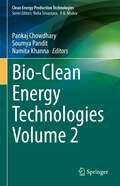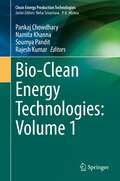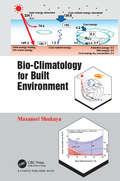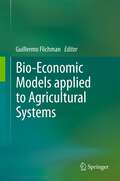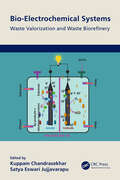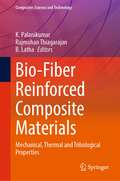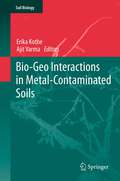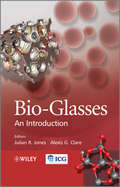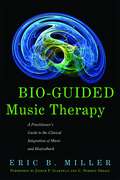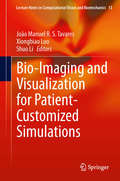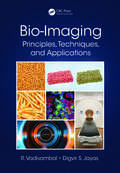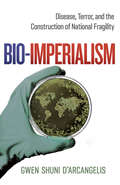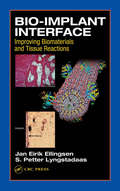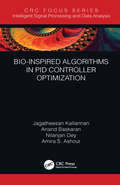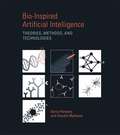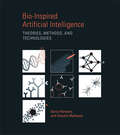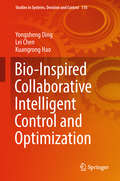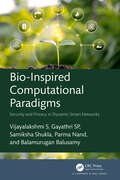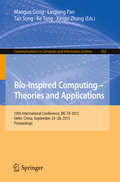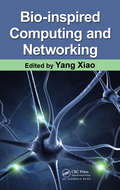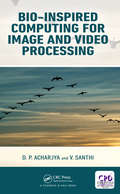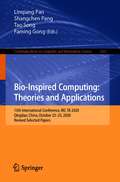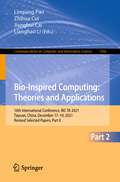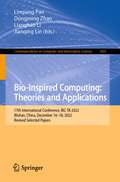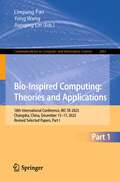- Table View
- List View
Bio-Clean Energy Technologies Volume 2 (Clean Energy Production Technologies)
by Pankaj Chowdhary Soumya Pandit Namita KhannaThis edited book discusses the latest advancements in the area of biofuel development. It covers extensive information regarding different aspects and types of biofuels. The book provides a road map of the various kinds of biofuels available for consideration. It focuses on microbial based power generation, applications of nanotechnology in biofuel development, advancements in molecular techniques, economic and life cycle assessments. The book also highlights the commercialization prospects and economics of the various processes and an overview of the life cycle assessment of the various different kinds of biofuels. The contributors are experienced professors, academicians and scientists associated with renowned laboratories and institutes in India and abroad. This book is of interest to teachers, researchers, biofuel scientists, capacity builders and policymakers. Also the book serves as additional reading material for undergraduate and graduate students. National and international scientists, policy makers will also find this to be a useful read.
Bio-Clean Energy Technologies: Volume 1 (Clean Energy Production Technologies)
by Rajesh Kumar Pankaj Chowdhary Soumya Pandit Namita KhannaThis book discusses the latest advancements in the area of biofuel development. It covers extensive information regarding different aspects and types of biofuels. The book provides a road map of the various different kinds of biofuels available for consideration, including both conventional and advanced algal based biofuels, replete with the economic analysis of their production and implementation. The contributors are experienced professors, academicians and scientists associated with renowned laboratories and institutes in India and abroad. This book is of interest to teachers, researchers, biofuel scientists, capacity builders and policymakers. Also the book serves as additional reading material for undergraduate and graduate students. National and international scientists, policy makers will also find this to be a useful read.
Bio-Climatology for Built Environment
by Masanori ShukuyaIndoor climate is determined by rational lighting, heating, cooling and ventilating systems. For occupants' well-being it should be consistent with how regional outdoor climate works in the flow of radiation via four paths of heat transfer: radiation; convection; conduction; and evaporation. This book starts with the relationship between the human body and its immediate environmental space followed by a brief introduction of passive and active systems for indoor climate conditioning. The nature of light and heat is discussed with a focus on building envelope systems such as walls and windows, and then examined from the viewpoint of thermodynamics and human-biology. Some examples are given to enable a better understanding of luminous and thermal characteristics of our most immediate environment particularly for those professionally involved in environmental planning, designing, and engineering to know about bio-climatic design principle.
Bio-Economic Models applied to Agricultural Systems
by Guillermo FlichmanThis book has the purpose of providing the "state of the arts" concerning bio-economic modelling dealing with agricultural systems. In most cases, the contributions use a methodology combining the use of biophysical and economic models, in all cases, an engineering production function approach is totally or partially applied. This practice is being developed in the last years as a response to concrete policy matters: agricultural policies are increasingly combined with environmental and natural resources policies, and this reality involves the need of an integrated assessment, that current economic models are not able to provide.
Bio-Electrochemical Systems: Waste Valorization and Waste Biorefinery
by Kuppam ChandrasekharThis book addresses electro-fermentation for biofuel production and generation of high-value chemicals and biofuels using organic wastes. It covers the use of microbial biofilm and algae-based bioelectrochemical systems (BESs) for bioremediation and co-generation of valuable chemicals, including their practical applications. It explains BES design, integrated approaches to enhance process efficiency, and scaling-up technology for waste remediation, bio-electrogenesis, and resource recovery from wastewater. Features: Provides information regarding bioelectrochemical systems, mediated value-added chemical synthesis, and waste remediation and resource recovery approaches. Covers the use of microbial biofilm and algae-based bioelectrochemical systems for bioremediation and co-generation of valuable chemicals. Explains waste-to-energy related concepts to treat industrial effluents along with bioenergy generation. Deals with various engineering approaches for chemicals production in eco-friendly manner. Discusses emerging electro-fermentation technology. This book is aimed at senior undergraduates and researchers in industrial biotechnology, environmental science, civil engineering, chemical engineering, bioenergy and biofuels, and wastewater treatment.
Bio-Fiber Reinforced Composite Materials: Mechanical, Thermal and Tribological Properties (Composites Science and Technology)
by K. Palanikumar Rajmohan Thiagarajan B. LathaThis book provides an overview on the latest technology and applications of bio-based fiber composite materials. It covers the mechanical and thermal properties of bio-fibers for polymeric resins and explains the different pre-treatment methods used by the researchers for the enhancement. In addition, this book also presents a complete analysis on the tribological behavior of bio-fiber reinforced polymer composites to appreciate the friction and wear behavior. This book would be a handy to the industrial practitioners and researchers in the direction of achieving optimum design for the components made of natural fiber based polymer matrix composites.
Bio-Geo Interactions in Metal-Contaminated Soils (Soil Biology #31)
by Ajit Varma Erika KotheMetal contamination is an increasing ecological and eco-toxicological risk. Understanding the processes involved in metal mobilization, sorption and mineralization in soils are key features for soil bioremediation. Following an introduction to the physical, chemical and biological components of contaminated soils, various chapters address the interactions of soil, microorganisms, plants and the water phase necessary to transfer metals into biological systems. These include topics such as potential hazards at mining sites; rare earth elements in biotic and abiotic acidic systems; manganese redox reactions; biomineralisation, uranium in seepage water; metal-resistant streptomycetes; mycorrhiza in re-forestation; metal (hyper)accummulation in plants; microbial metal uptake; and their potential for bioremediation. This book will be of interest to soil biologists, geologists and chemists, researchers and graduate students, as well as consulting companies and small enterprises involved in bioremediation.
Bio-Glasses: An Introduction
by Alexis Clare Julian JonesThis new work is dedicated to glasses and their variants which can be used as biomaterials to repair diseased and damaged tissues. Bio-glasses are superior to other biomaterials in many applications, such as healing bone by signaling stem cells to become bone cells. Key features: First book on biomaterials to focus on bio-glassesEdited by a leading authority on bio-glasses trained by one of its inventors, Dr Larry HenchSupported by the International Commission on Glass (ICG)Authored by members of the ICG Biomedical Glass Committee, with the goal of creating a seamless textbookWritten in an accessible style to facilitate rapid absorption of informationCovers all types of glasses, their properties and applications, and demonstrates how glass is an attractive improvement to current proceduresOf interest to the biomedical as well as the materials science community. The book covers all types of glasses: traditional glasses, bioactive glasses, sol-gel glasses, phosphate glasses, glass-ceramics, composites and hybrids. Alongside discussion on how bio-glasses are made, their properties, and the reasons for their use, the authors also cover their applications in dentistry, bone regeneration and tissue engineering and cancer treatment. Its solid guidance describes the steps needed to take a new material from concept to clinic, covering the essentials of patenting, scale-up, quality assurance and FDA approval.
Bio-Guided Music Therapy
by Eric B. MillerBio-Guided Music Therapy explores the clinical integration of music and biofeedback, providing the practitioner with a rationale, historical context and detailed step-by-step instructions for implementing real-time physiological data driven music therapy. This practical guide introduces the fundamental principles of biofeedback and explores the use of music therapy interventions in the context of achieving skills in self-regulation of physiological response. The book looks at the primary modalities of biofeedback, in conjunction with the assignment of digitally sampled musical voices to specific body functions. Additional music therapy interventions discussed include guided imagery to music, toning, mantra meditation, drumming and improvisation. We see how physiological data taken in the moment and combined with music therapy techniques, may be successfully applied to the treatment of stress, anxiety, high blood pressure, chronic pain, dementia, migraine, ADHD and addictions. Instructive and accessible, this book will prove an essential resource for students and practitioners of music therapy, biofeedback practitioners, social workers, psychologists and healing arts professionals.
Bio-Imaging and Visualization for Patient-Customized Simulations (Lecture Notes in Computational Vision and Biomechanics #13)
by Xiongbiao Luo Shuo Li João Manuel R. S. TavaresThis book contains the full papers presented at the MICCAI 2013 workshop Bio-Imaging and Visualization for Patient-Customized Simulations (MWBIVPCS 2013). MWBIVPCS 2013 brought together researchers representing several fields, such as Biomechanics, Engineering, Medicine, Mathematics, Physics and Statistic. The contributions included in this book present and discuss new trends in those fields, using several methods and techniques, including the finite element method, similarity metrics, optimization processes, graphs, hidden Markov models, sensor calibration, fuzzy logic, data mining, cellular automation, active shape models, template matching and level sets. These serve as tools to address more efficiently different and timely applications involving signal and image acquisition, image processing and analysis, image segmentation, image registration and fusion, computer simulation, image based modelling, simulation and surgical planning, image guided robot assisted surgical and image based diagnosis. This book will appeal to researchers, PhD students and graduate students with multidisciplinary interests related to the areas of medical imaging, image processing and analysis, computer vision, image segmentation, image registration and fusion, scientific data visualization and image based modeling and simulation.
Bio-Imaging: Principles, Techniques, and Applications
by Rajagopal Vadivambal Digvir S. JayasHighlights the Emergence of Image Processing in Food and AgricultureIn addition to uses specifically related to health and other industries, biological imaging is now being used for a variety of applications in food and agriculture. Bio-Imaging: Principles, Techniques, and Applications fully details and outlines the processes of bio-imaging applica
Bio-Imperialism: Disease, Terror, and the Construction of National Fragility
by Gwen Shuni D'ArcangelisBio-Imperialism focuses on an understudied dimension of the war on terror: the fight against bioterrorism. This component of the war enlisted the biosciences and public health fields to build up the U.S. biodefense industry and U.S. global disease control. The book argues that U.S. imperial ambitions drove these shifts in focus, aided by gendered and racialized discourses on terrorism, disease, and science. These narratives helped rationalize American research expansion into dangerous germs and bioweapons in the name of biodefense and bolstered the U.S. rationale for increased interference in the disease control decisions of Global South nations. Bio-Imperialism is a sobering look at how the war on terror impacted the world in ways that we are only just starting to grapple with.
Bio-Implant Interface: Improving Biomaterials and Tissue Reactions
by J.E. Ellingsen S.P. LyngstadaasAchieving good clinical outcomes with implanted biomaterials depends upon achieving optimal function, both mechanical and biological, which in turn depends upon integrating advances realized in biological science, material science, and tissue engineering. As these advances push back the frontiers of biomaterial medicine , the control and patterning
Bio-Inspired Algorithms in PID Controller Optimization (Intelligent Signal Processing and Data Analysis)
by Nilanjan Dey Jagatheesan Kallannan Anand Baskaran Amira AshourThis book discusses in-depth role of optimization to optimize the controller parameters with reference to bio-inspired algorithms. Comparative studies to evaluate the performance of different optimization techniques in terms of the settling time, overshoot and undershoot responses of the frequency deviations, tie-line power flow deviations, and the area control error are included, supported by examples. The book also includes different scenarios of the load frequency controller for single area as well as multi-area thermal power generating unit considering different algorithms. Key Features: Highlights the importance of tuning the power system controller parameters with emphasis on bio-inspiration algorithms Provides some applied applications/examples of the thermal power system Focusses on power system applications based on the optimization algorithms with different single area and multi-area thermal power systems Reports different cases on the interconnected power systems with providing optimal performance by optimizing the controller’s parameters
Bio-Inspired Artificial Intelligence: Theories, Methods, and Technologies
by Dario Floreano Claudio MattiussiNew approaches to artificial intelligence spring from the idea that intelligence emerges as much from cells, bodies, and societies as it does from evolution, development, and learning. Traditionally, artificial intelligence has been concerned with reproducing the abilities of human brains; newer approaches take inspiration from a wider range of biological structures that that are capable of autonomous self-organization. Examples of these new approaches include evolutionary computation and evolutionary electronics, artificial neural networks, immune systems, biorobotics, and swarm intelligence--to mention only a few. This book offers a comprehensive introduction to the emerging field of biologically inspired artificial intelligence that can be used as an upper-level text or as a reference for researchers. Each chapter presents computational approaches inspired by a different biological system; each begins with background information about the biological system and then proceeds to develop computational models that make use of biological concepts. The chapters cover evolutionary computation and electronics; cellular systems; neural systems, including neuromorphic engineering; developmental systems; immune systems; behavioral systems--including several approaches to robotics, including behavior-based, bio-mimetic, epigenetic, and evolutionary robots; and collective systems, including swarm robotics as well as cooperative and competitive co-evolving systems. Chapters end with a concluding overview and suggested reading.
Bio-Inspired Artificial Intelligence: Theories, Methods, and Technologies (Intelligent Robotics and Autonomous Agents)
by Dario Floreano Claudio MattiussiA comprehensive introduction to new approaches in artificial intelligence and robotics that are inspired by self-organizing biological processes and structures. New approaches to artificial intelligence spring from the idea that intelligence emerges as much from cells, bodies, and societies as it does from evolution, development, and learning. Traditionally, artificial intelligence has been concerned with reproducing the abilities of human brains; newer approaches take inspiration from a wider range of biological structures that that are capable of autonomous self-organization. Examples of these new approaches include evolutionary computation and evolutionary electronics, artificial neural networks, immune systems, biorobotics, and swarm intelligence—to mention only a few. This book offers a comprehensive introduction to the emerging field of biologically inspired artificial intelligence that can be used as an upper-level text or as a reference for researchers. Each chapter presents computational approaches inspired by a different biological system; each begins with background information about the biological system and then proceeds to develop computational models that make use of biological concepts. The chapters cover evolutionary computation and electronics; cellular systems; neural systems, including neuromorphic engineering; developmental systems; immune systems; behavioral systems—including several approaches to robotics, including behavior-based, bio-mimetic, epigenetic, and evolutionary robots; and collective systems, including swarm robotics as well as cooperative and competitive co-evolving systems. Chapters end with a concluding overview and suggested reading.
Bio-Inspired Collaborative Intelligent Control and Optimization (Studies in Systems, Decision and Control #118)
by Lei Chen Yongsheng Ding Kuangrong HaoThis book presents state-of-the-art research advances in the field of biologically inspired cooperative control theories and their applications. It describes various biologically inspired cooperative control and optimization approaches and highlights real-world examples in complex industrial processes. Multidisciplinary in nature and closely integrating theory and practice, the book will be of interest to all university researchers, control engineers and graduate students in intelligent systems and control who wish to learn the core principles, methods, algorithms, and applications.
Bio-Inspired Computational Paradigms: Security and Privacy in Dynamic Smart Networks
by Samiksha Shukla Parma Nand Vijayalakshmi S Gayathri SpSmart cities with various technological innovations have played an important role and influenced society as well. Due to voluminous data transactions within smart cities, security and privacy concerns need to be dealt with. Though taking care of safety and privacy is challenging, it is essential for a smart city to understand the bio-inspired computing paradigms. This book discusses the utilization of bio-inspired computing procedures for effective computational devices.• Discusses real-world usage of bio-inspired computations• Highlights how bio-inspired computations hold the potential to significantly increase network security and privacy• Talks about how society can avoid consequences of cyber security breaches• Examines the combination of bio-inspired computational methods with IoT, AI and big dataThis book is primarily aimed at graduates, researchers, IT and industry professionals.
Bio-Inspired Computing -- Theories and Applications: 10th International Conference, BIC-TA 2015 Hefei, China, September 25-28, 2015, Proceedings (Communications in Computer and Information Science #562)
by Maoguo Gong Linqiang Pan Tao Song Ke Tang Xingyi ZhangThis book constitutes the proceedings of the 10th International Conference on Bio-Inspired Computing: Theories and Applications, BIC-TA 2015, held in Hefei, China, in September 2015. The 63 revised full papers presented were carefully reviewed and selected from 182 submissions. The papers deal with the following main topics: evolutionary computing, neural computing, DNA computing, and membrane computing.
Bio-Inspired Computing and Networking
by Yang XiaoSeeking new methods to satisfy increasing communication demands, researchers continue to find inspiration from the complex systems found in nature. From ant-inspired allocation to a swarm algorithm derived from honeybees, Bio-Inspired Computing and Networking explains how the study of biological systems can significantly improve computing, networki
Bio-Inspired Computing for Image and Video Processing
by V. Santhi D. P. AcharjyaIn recent years bio-inspired computational theories and tools have developed to assist people in extracting knowledge from high dimensional data. These differ in how they take a more evolutionary approach to learning, as opposed to traditional artificial intelligence (AI) and what could be described as 'creationist' methods. Instead bio-inspired computing takes a bottom-up, de-centralized approach that often involves the method of specifying a set of simple rules, a set of simple organisms which adhere to those rules, and of iteratively applying those rules. Bio-Inspired Computing for Image and Video Processing covers interesting and challenging new theories in image and video processing. It addresses the growing demand for image and video processing in diverse application areas, such as secured biomedical imaging, biometrics, remote sensing, texture understanding, pattern recognition, content-based image retrieval, and more. This book is perfect for students following this topic at both undergraduate and postgraduate level. It will also prove indispensable to researchers who have an interest in image processing using bio-inspired computing.
Bio-Inspired Computing: 15th International Conference, BIC-TA 2020, Qingdao, China, October 23-25, 2020, Revised Selected Papers (Communications in Computer and Information Science #1363)
by Linqiang Pan Tao Song Shangchen Pang Faming GongThis volume constitutes the revised selected papers of the 15th International Conference on Bio-inspired Computing: Theories and Applications, BIC-TA 2020, held in Qingdao, China, in October 2020.The 43 full papers presented in both volumes were selected from 109 submissions. The papers are organized according to the topical headings: evolutionary computation and swarm intelligence; neural networks and machine learning; DNA computing and membrane computing.
Bio-Inspired Computing: 16th International Conference, BIC-TA 2021, Taiyuan, China, December 17–19, 2021, Revised Selected Papers, Part II (Communications in Computer and Information Science #1566)
by Linqiang Pan Zhihua Cui Jianghui Cai Lianghao LiThis two-volume set (CCIS 1565 and CCIS 1566) constitutes selected and revised papers from the 16th International Conference on Bio-Inspired Computing: Theories and Applications, BIC-TA 2021, held in Taiyuan, China, in December 2021. The 67 papers presented were thoroughly reviewed and selected from 211 submissions. The papers are organized in the following topical sections: evolutionary computation and swarm intelligence; DNA and molecular computing; machine learning and computer vision.
Bio-Inspired Computing: 17th International Conference, BIC-TA 2022, Wuhan, China, December 16–18, 2022, Revised Selected Papers (Communications in Computer and Information Science #1801)
by Linqiang Pan Lianghao Li Dongming Zhao Jianqing LinThis book constitutes the refereed proceedings of the 17th International Conference on Bio-Inspired Computing: Theories and Applications, BIC-TA 2022, held in Wuhan, China, during December 16–18, 2022.The 56 full papers included in this book were carefully reviewed and selected from 148 submissions. They were organized in topical sections as follows: evolutionary computation and swarm intelligence; machine learning and deep learning; intelligent control and simulation and molecular computing and nanotechnology.
Bio-Inspired Computing: 18th International Conference, BIC-TA 2023, Changsha, China, December 15–17, 2023, Revised Selected Papers, Part I (Communications in Computer and Information Science #2061)
by Yong Wang Linqiang Pan Jianqing LinThe two-volume set CCIS 2061 and 2062 constitutes the refereed post-conference proceedings of the 18th International Conference on Bio-Inspired Computing: Theories and Applications, BIC-TA 2023, held in Changsha, China, during December 15–17, 2023.The 64 revised full papers presented in these proceedings were carefully reviewed and selected from 168 submissions. The papers are organized in the following topical sections: Volume I: Evolutionary Computation and Swarm Intelligence; and Membrane Computing and DNA ComputingVolume II: Machine Learning and Applications; and Intelligent Control and Application.
